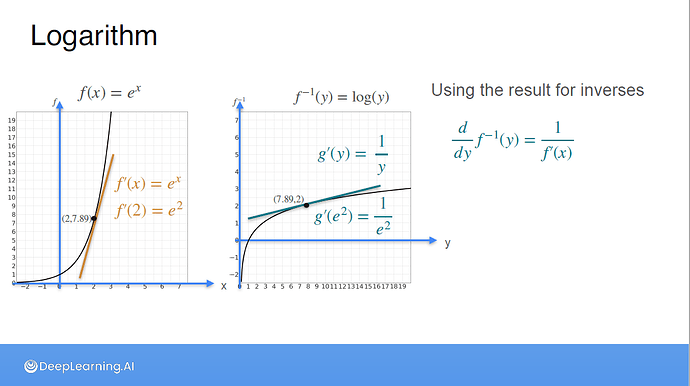Hey @Hartej_Dhiman,
I really appreciate your post. It’s something even I got confused in when I was going over the content myself. Let us start from the foundation. First, we will borrow the result from the lecture video “The inverse function and it’s derivative”, i.e.,
g'(y) = \frac{1}{f'(x)}, where \\
g(x) = f^{-1}(x), and \\
y = f(x)
If you are confused with this much, then I recommend you to watch this lecture video once again, since I have just stated the result from the lecture video. Now, let’s move on to understand how we can obtain the derivative of log from this property. In the video “The derivative of log(x)”, it was established that log(x) is the inverse of e^x, i.e., log(e^x) = x.
So, let’s say that g(y) = log(y) and f(x) = e^x, where f and g are inverse of each other. We invoke the result from before:
g'(y) = \frac{1}{f'(x)}, where \\
f'(x) = \frac{d}{dx} e^x = e^x, \\
=> g'(y) = \frac{1}{e^x}
Now, note that from the result, we also have y = f(x) = e^x. So, we substitute e^x with y on the RHS on the equation, so that we can get an expression for g'(y) in terms of y. So, we have:
g'(y) = 1 / y, or \\
\frac{d}{dy} log(y) = \frac{1}{y}
Voila, we have the derivative of log(y) or log(x)  Now, let’s go ahead, and break down your thoughts on this as well.
Now, let’s go ahead, and break down your thoughts on this as well.
I guess this is very easy to understand. Since we have y = f(x), it means, we can rewrite this as x = f^{-1}(y), and now, we have simply substituted x with f^{-1}(y), in the above equation.
You are correct on this.
You are mistaken on this. One is not supposed to see any equality between these 2. The result states that \frac{1}{e^x} is equal to the derivative of log(y), as I have mentioned above.
Let us know if you still have any confusion on this, and we will be more than happy to help you out.
Cheers,
Elemento


